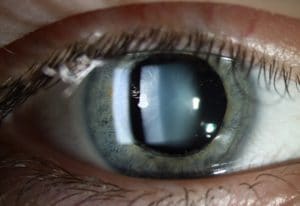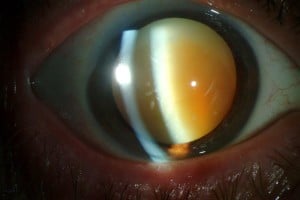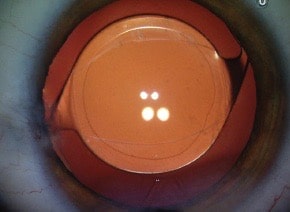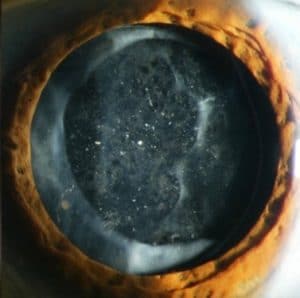Cataracts

Clear lens with slit lamp
A Cataract is a clouding of the lens of the eye. The lens sits right behind the pupil which is the black spot in the center of your eye. Light passes through the pupil and is focused onto the retina in the back of the eye by the lens.

Cloudy lens with slit lamp
When we are young the lens is clear, but as we age the lens begins to get cloudy. So, instead of focusing light, the cloudy lens scatters the light creating blurred vision and glare. Most of the time, this is a very slow developing process so symptoms can go unnoticed for some time.
Causes
The main cause of Cataracts is age, but there are many other risk factors that can accelerate Cataract growth including Diabetes and chronic use of medicines containing Cortisone and its derivatives. Injuries or previous surgery to the eye are also risk factors.
Symptoms
The primary symptoms of Cataracts are blurring and glare. Often time people complain of a “film” over their eye or are troubled by glare when driving, especially at night when Cataracts seem to exert more effect. Another symptom would be requiring more light in order to read.
Diagnosis
Cataracts are diagnosed during your exam in the office. They are readily visualized through the microscope. Glare testing will be performed to further assess the level of severity.
Treatment
The treatment for Cataracts is surgery which is one of the most common eye operations performed in the United States. The operation usually takes 15 – 20 minutes and is outpatient. You usually go home within minutes after the surgery and can get back to daily activities real soon.
As part of the Cataract operation an artificial lens is inserted in the eye right where the Cataract was removed. This is called an Intraocular Lens (IOL) or Lens Implant. Modern technology has created different types of IOL’s for different circumstances with the goal in mind to reduce your need for glasses as much as possible. Please click here to learn more about lens implants. Detailed testing pre-op will allow your doctor to council you on the best choice of Lens Implant based on your visual needs. However, despite advances in technology, pre-op testing is still only about 65% accurate in predicting the correct IOL power. To improve accuracy, measurements can be performed at the time of Cataract surgery using the ORA system. Please watch the video below for a demonstration of the ORA system in action. This allows for 90% accuracy in achieving the desired outcome.
Secondary Cataract
People often ask if a cataract can recur. The answer is “yes and no.” The clear membrane that holds the lens implant in place can cloud up at any time after surgery, thus blurring your vision. In fact, this happens at least 50% of the time, so it is quite common. The term for this cloudy membrane is “Secondary Cataract” or “Posterior Capsule Opacification (PCO).”

Clear Capsule

Opacified Capsule.
Fortunately, there is a laser treatment done in office to correct this. This is called YAG laser posterior capsulotomy. This procedure is quick and painless!
At L.O.C., we bring over 30 years of experience with small incision Cataract surgery. We pride ourselves in keeping up with all the latest technologic developments and will strive to do our best for your visual needs.
